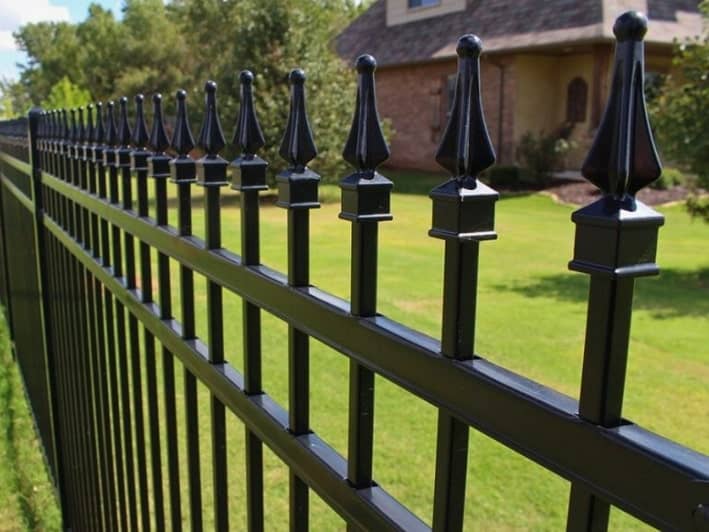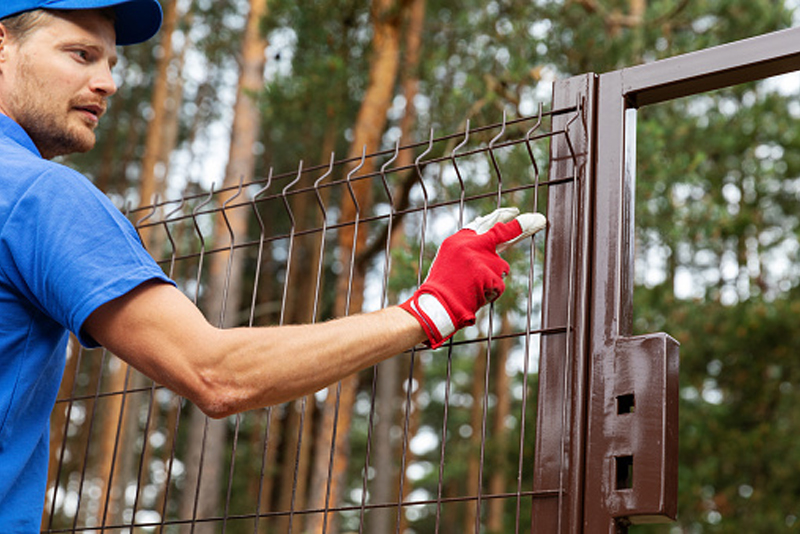Why a Licensed Fence Contractor Is Worth the Investment
Why a Licensed Fence Contractor Is Worth the Investment
Blog Article
How to Determine Common Concerns That Need Immediate Fencing Fixing
It is critical to detect concerns before they come to be larger issues when it comes to preserving your fencing. On a regular basis looking for indicators of rotting wood, leaning panels, or corrosion can save you time and cash over time. You could not understand just how climate and pests can compromise your fencing's integrity. Let's discover the common signs that suggest your fence needs instant interest, so you can keep your residential or commercial property safe and secure and looking its best.
Indications of Rotting Timber in Wooden Fences
Have you seen your wood fence looking a bit worse for wear? It could be time to inspect for signs of rotting timber if so. Initially, take a look at the base of the articles and panels for soft spots. That's a clear indication of rot if you push on the wood and it really feels mushy or crumbles. Next off, seek discoloration or dark spots on the timber-- these commonly signal wetness damage. Take notice of any type of peeling off paint or surface, as this can subject the timber to further degeneration. Additionally, a pungent, stuffy odor can suggest fungal growth. Do not forget to evaluate joints and links; if they hang or breaking down, the wood beneath is likely compromised. By catching these indicators early, you can protect against a lot more considerable damage and maintain your fencing standing solid. Routine maintenance is essential to expanding the life of your wood fence.
Leaning or Tilting Fencing Panels
If you have actually noticed your fence panels leaning or turning, it's crucial to recognize what caused it. This problem could indicate underlying structural damage that needs your focus. Let's check out the usual causes and the repair service options readily available to get your fencing back in form.

Causes of Leaning Panels
When you observe your fence panels leaning or tilting, it's frequently an indication of underlying problems that require dealing with. One common cause is poor water drainage; excessive water can erode the soil around the fence blog posts, compromising their assistance. An additional perpetrator could be solid winds or storms that press versus the panels, specifically if they're not properly anchored. In addition, the all-natural settling of soil in time can trigger posts to shift, causing a tilt. Parasites, like termites, can endanger the stability of wooden panels, triggering them to lean as well. Ultimately, bad setup techniques may lead to panels not being safely established, leaving them at risk to leaning under stress. Address these concerns without delay to keep your fencing's honesty.
Indicators of Architectural Damage
Observing turning or leaning fencing panels can be disconcerting, as these concerns usually suggest architectural damage that requires immediate interest. When your fence starts to lean, it may indicate that the posts are changing or that the soil around them has actually deteriorated. Pay attention to gaps in between posts or panels, as these can additionally suggest instability. deck builder. Additionally, check for cracks or splintering in the timber, which can damage the total structure. It might endanger the stability of the fencing if you discover corrosion or deterioration on steel parts. Bear in mind, neglecting these indications can cause much more extreme damage down the line, so it's vital to evaluate the situation quickly and take activity before it intensifies
Repair Options Available

Corrosion and Deterioration in Steel Fences
If you own a metal fencing, you could discover rust and corrosion slipping in with time, particularly if it's revealed to wetness. These concerns not only affect the look of your fence but can likewise endanger its structural honesty. To determine rust, look for reddish-brown spots or patches, which indicate the steel is oxidizing. Corrosion can spread quickly if left untreated, weakening the fencing and leading to costly repairs.To take on rust and corrosion, you must cleanse the influenced areas with a cable brush and apply a rust-inhibiting primer. When the guide dries, consider painting the fence with a weather-resistant paint to safeguard it additionally. Regular upkeep, such as checking for indicators of rust and touching up paint as needed, will certainly help extend your fencing's life expectancy. Attending to these problems without delay assures your metal fence stays solid and aesthetically appealing for several years to find.
Fractures and Divides in Vinyl Fencing

Sources Of Plastic Damage
Vinyl secure fencing is popular for its durability, yet it can still experience cracks and divides as a result of different variables. One major cause is extreme temperature fluctuations. It can compromise the product over time when plastic expands in the warmth and agreements in the chilly. Furthermore, exposure to rough sunlight can bring about UV deterioration, making the plastic fragile. Physical impacts, like heavy branches or unintentional accidents, can also produce splits. Poor setup or using low-quality products can aggravate these issues. Moreover, linked here age plays a duty; older vinyl fencing is extra susceptible to damages. Regular assessments can assist you recognize these variables before they cause considerable problems. Take proactive measures to assure your fence stays intact and strong.
Fixing Cracks Properly
Although splits and splits in your plastic secure fencing can be concerning, resolving them quickly can protect against further damage and keep the fencing's appearance. Examine the size of the crack. For little fractures, a vinyl fixing set frequently includes adhesive that can bond the sides, supplying a smooth solution. Clean the location extensively before applying the adhesive, ensuring it adheres appropriately. For bigger divides, you may require to make use of a vinyl spot. Cut the patch to size, apply adhesive around the sides, and press it securely onto the split. Permit it to cure according to the supplier's directions. Routine upkeep and fast repair work can expand your fence's life-span, keeping it looking excellent for many years to come.
Loose or Missing Fence Blog Posts
Missing or loosened fence articles can threaten the stability of your whole fence framework. It's essential to attend to the problem instantly if you observe any type of articles wobbling or leaning. Look for any kind of indicators of activity, as this can result in further damage with time. You can conveniently assess the trouble by offering each message a gentle shake-- if it really feels unstable, it's time to take action.For missing out on articles, you'll require to change them as soon as feasible to maintain your fencing's stability. Make sure they're firmly secured in the ground with concrete or gravel for added security when you install new posts. If an article hangs, tighten it by adding additional support or driving it deeper right into the ground.Ignoring these problems can bring about larger troubles, like gaps in your fence or perhaps full collapse. Maintain an eye on your articles and remain proactive regarding repair work!
Damages From Weather Condition and Natural Environment
Weather and natural environments can create mayhem on your fencing, bring about various forms of damages that need timely focus. Heavy rainfall can trigger timber to rot, making it weak and unstable. Snow build-up could bend or damage panels, while strong winds can root out fence blog posts or cause sections to lean.If you discover splits or splintering in wooden fences, it signifies drying due to intense sun direct exposure. Meanwhile, metal fences can corrosion if protective finishes disappear, particularly in damp or coastal areas.Inspect your fencing consistently after storms or extreme weather to capture any kind of damage early. Addressing these problems quickly can save you from costly repairs down the line. Do not wait until a tiny problem becomes a major one; remain proactive and maintain your surround leading shape to keep both performance and visual charm.
Bug Invasion and Termite Damages
It's important to act rapidly to avoid further devastation when you observe signs of bug invasion or termite damage. Search for mud tubes along your fencing or hollow-sounding wood, as these show termites are at work. You might likewise see small openings or frass, which is termite droppings looking like sawdust. If you detect any one of these indications, it's time to evaluate the damage.Don' t delay till it's also late; pests can jeopardize your fencing's honesty. Inspect the surrounding area for ants or beetles, as they might be contributing to the problem. If you believe an infestation, consider getting in touch with a parasite control specialist to validate and treat the issue.Repairing or replacing affected sections of your fence immediately not just restores its toughness but likewise avoids parasites from spreading better. Stay alert to keep your residential or commercial property protected and pest-free.
Frequently Asked Questions
Just how Frequently Should I Evaluate My Fence for Damage?
You must examine your fence a minimum of two times a year, ideally during spring and fall. Regular checks aid you find damage site here early, saving you money and time on repair services while preserving your residential property's appearance and safety.
Can I Fix a Fencing Myself or Employ an Expert?
If you have the right tools and abilities, you can definitely fix a fence on your own. Nevertheless, hiring a specialist warranties top quality job and saves you time, particularly for complicated fixings or comprehensive damages.
What Tools Are Needed for Fundamental Fencing Repairs?
For fundamental fencing fixings, you'll need devices like a hammer, screwdriver, pliers, a saw, a level, and measuring tape. deck builder. Relying on the repair work, you might additionally require nails, screws, or replacement boards
Just How Much Does Fence Repair Service Commonly Cost?
Fencing repair work expenses vary widely, yet you can expect to pay between $200 and $1,500 relying on materials, labor, and degree of damages. It's smart to get numerous quotes for the best offer.
When Is the Best Time of Year for Fence Repairs?
The ideal time for fencing repair services is during moderate climate, usually in spring or early loss. You'll stay clear of extreme temperatures, making it much easier to work and ensuring the materials established properly for lasting longevity (deck builder). Discovering turning or leaning fencing panels visit our website can be startling, as these concerns commonly indicate structural damages that needs immediate focus. Loosened or missing fence messages can threaten the stability of your entire fencing structure. Snow accumulation may flex or damage panels, while solid winds can uproot fencing articles or cause areas to lean.If you discover cracks or splintering in wood fences, it's an indicator of drying out due to intense sun direct exposure. Steel fences can corrosion if safety layers use off, especially in coastal or moist areas.Inspect your fence regularly after storms or extreme weather condition to capture any damage early. Fencing repair service costs differ widely, yet you can expect to pay in between $200 and $1,500 depending on materials, labor, and degree of damages
Report this page